
The origins of the harp are in Asia Minor at the time of the first Sumerian dynasties.
The existence of arched harp developed from the first half of the third millennium, suggesting that the instrument
had already gone through a long development period. The arched harp (the handle bent) is played horizontally
or vertically, sometimes with a plectrum.
She seems to coexist at the same time in Egypt during the Old Kingdom and later developed during
Middle and New Kingdom in a variety of forms with sometimes impressive proportions. During the Lower Epoque
sleeves, more or less arched, are sometimes adorned with a carved head at the upper end.
The massive Ennedi, located north-east of Chad, is rich in prints and the most ancient rock paintings
back to the fourth millennium. The variety of styles and figurative scenes situates the chronology of different periods;
the representation of several harpists on paintings from the recent Bovidian period (first millennium)
attests to the remote existence of the arched harp in this region of Saharan Africa.
The model presented is coming from Kenya.









